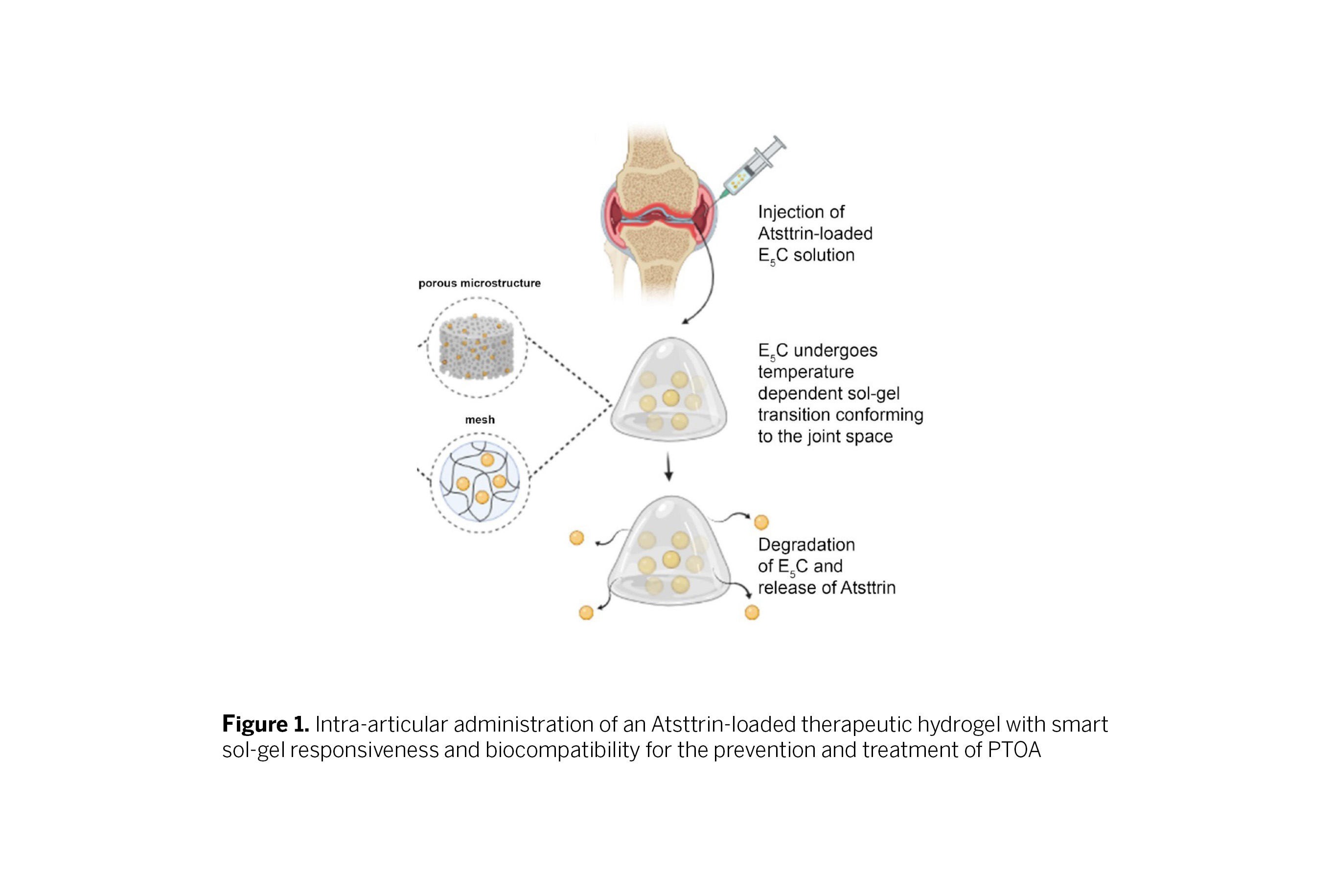Injectable Therapeutic Hydrogel for the Treatment of Post-Traumatic Osteoarthritis
Injectable, minimally invasive, and effective disease-modifying therapeutic for post-traumatic osteoarthritis (PTOA) prevention and treatment

Technology
The Montclare and Liu Labs have engineered an injectable therapeutic hydrogel for the stimulation of cartilage regeneration and the protection of bone quality in PTOA. The Montclare Group has expertise in protein-engineered block co-polymers and hydrogel design; whereas, the Liu Lab has expertise in development of peptide-based therapeutics to treat arthritis. Their engineered hydrogel contains a therapeutic agent termed Atsttrin (Antagonist of TNF/TNFR Signaling via Targeting to TNF Receptors), a synthetic protein derivative of the growth factor progranulin, that can block aberrant TNFα signaling leading to inflammatory and apoptotic responses (see Fig. 1 on next page). Unlike other conventional approaches, this innovative hydrogel comprised of the E5C protein has the ability to exhibit smart sol-gel response (i.e., polymerization) at body temperature. As described in foundational work (P. Katyal et al. 2022), the inventors developed a thermoresponsive E5C-based hydrogel capable of a) exhibiting smart sol-gel response at body temperature with enhanced biocompatibility and improved biodegradability; b) encapsulating the therapeutic agent, Atsttrin, known to have anti-inflammatory and chondroprotective effects in PTOA; and c) providing a sustained and controlled release of that agent, leading to enhanced chondrocyte migration, proliferation, and metabolism. In proof-of-concept efficacy studies, the injectable Atsttrin-loaded E5C hydrogel showed protective effects in a rabbit PTOA model.
Background
Osteoarthritis is a disease that affects 13% of the world's population where 54% of patients that experience osteoarthritis require a joint replacement within 13 years of disease onset. PTOA is defined by articular cartilage damage induced by sudden application of mechanical force. The current treatment entails total joint replacement, an invasive surgical procedure, which is often associated with infections and may need a revision knee replacement. Once onset begins, current treatments are only capable of providing temporary pain management. Neither a disease-modifying OA drug nor a non-surgical cure presently exists. Unfortunately, not only do these treatments (including the popular non-invasive hydrogel hyaluronic acid) not change the underlying disease progression in the joint causing pain, but there is also a lack of consensus in the scientific literature as to whether they prevent pain. Therefore, there is an urgent and unmet need to develop non-invasive, analgesic, and disease-modifying PTOA therapies.
Development Status
Atsttrin has been extensively tested and validated in pre-clinical studies and the Asttrin-loaded hydrogel has demonstrated efficacy in a PTOA mouse model. The next planned step is to prepare a Pre-Request for Designation (Pre-RFD) with the FDA.
Application
The treatment and/or prevention of PTOA
Advantages
- Disease-modifying potential: The Atsttrin peptide can regenerate cartilage and protect bone quality
- Minimally invasive and inexpensive: No surgery is required and material injected is not cost-prohibitive
- Analgesic benefits: Hydrogel component may provide pain relief and lubrication of the cartilage
- Controlled release mechanism: Hydrogel slowly releases Atsttrin leading to enhanced chondrocyte migration, proliferation, and metabolism
- Favorable biocompatibility: Hydrogel exhibits smart sol-gel response at body temperature
Intellectual Property
U.S. non-provisional patents have issued covering the protein hydrogel composition and method of use (US9554997 and US9370491). NYU holds multiple issued patents in the US and other jurisdictions covering the protein therapeutic agent (US8362218, US8871915, JP5822822, CN201080028432.3, FR2419121, DE602010052016.1, and UK2419121)
-
expand_more mode_edit Authors (2)Jin Kim Montclare, PhDChuan-Ju Liu, PhD
-
expand_more library_books References (2)
- Chuan-ju Liu, et al , The growth factor progranulin binds to TNF receptors and is therapeutic against inflammatory arthritis in mice
- Jin Kim Montclare, Chuan-Ju Liu, et al , Injectable recombinant block polymer gel for sustained delivery of therapeutic protein in post traumatic osteoarthritis
-
expand_more cloud_download Supporting documents (1)Product brochureInjectable Therapeutic Hydrogel for the Treatment of Post-Traumatic Osteoarthritis.pdf